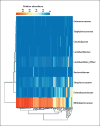Differential Establishment of Bifidobacteria in the Breastfed Infant Gut
- PMID: 28346936
- PMCID: PMC5535791
- DOI: 10.1159/000455399
Differential Establishment of Bifidobacteria in the Breastfed Infant Gut
Abstract
The composition of an infant's gut microbiome can impact their immediate and long-term health. Bifdobacteria play a major role in structuring the gut microbiome of breastfed infants due to their ability to consume oligosaccharides found in human milk. However, recent studies have revealed that bifidobacteria are often absent in the gut microbiome of breastfed infants in some locations. This lack of colonization may be due either to differences in the environmental conditions in the gastrointestinal tract of uncolonized infants which prohibit the growth of bifidobacteria or a dearth of sources from which infants may acquire these specialized bacterial species. Potential mechanisms by which these broad factors may lead to lower colonization of infants by bifidobacteria are discussed herein. Environmental conditions which may select against bifidobacteria include low rates/duration of breastfeeding, milk glycan composition, and antimicrobial use. Routes of colonization by bifidobacteria which may be disrupted include maternal transfer via vaginal birth, fecal-oral routes, or via breast milk itself. A careful contemplation of the conditions experienced by bifidobacteria over human evolutionary history may lead to further hypotheses as to the causative factors of the differential colonization by this foundation genus in some contemporary locations.
© 2017 Nestec Ltd., Vevey/S. Karger AG, Basel.
Figures

Similar articles
-
Varied Pathways of Infant Gut-Associated Bifidobacterium to Assimilate Human Milk Oligosaccharides: Prevalence of the Gene Set and Its Correlation with Bifidobacteria-Rich Microbiota Formation.Nutrients. 2019 Dec 26;12(1):71. doi: 10.3390/nu12010071. Nutrients. 2019. PMID: 31888048 Free PMC article. Review.
-
Development of an infant colon simulating in vitro model, I-TIM-2, to study the effects of modulation strategies on the infant gut microbiome composition and function.Microbiol Spectr. 2024 Nov 5;12(11):e0072424. doi: 10.1128/spectrum.00724-24. Epub 2024 Oct 8. Microbiol Spectr. 2024. PMID: 39377603 Free PMC article.
-
Multilocus sequence typing of bifidobacterial strains from infant's faeces and human milk: are bifidobacteria being sustainably shared during breastfeeding?Benef Microbes. 2015;6(4):563-72. doi: 10.3920/BM2014.0082. Epub 2015 Apr 22. Benef Microbes. 2015. PMID: 25691099
-
Maternal breast-milk and intestinal bifidobacteria guide the compositional development of the Bifidobacterium microbiota in infants at risk of allergic disease.Clin Exp Allergy. 2007 Dec;37(12):1764-72. doi: 10.1111/j.1365-2222.2007.02849.x. Epub 2007 Oct 16. Clin Exp Allergy. 2007. PMID: 17941914 Clinical Trial.
-
Impact of human milk bacteria and oligosaccharides on neonatal gut microbiota establishment and gut health.Nutr Rev. 2015 Jul;73(7):426-37. doi: 10.1093/nutrit/nuu016. Epub 2015 Apr 15. Nutr Rev. 2015. PMID: 26081453 Review.
Cited by
-
Microbiota, metabolic profiles and immune biomarkers in infants receiving formula with added bovine milk fat globule membrane: a randomized, controlled trial.Front Nutr. 2024 Oct 4;11:1465174. doi: 10.3389/fnut.2024.1465174. eCollection 2024. Front Nutr. 2024. PMID: 39444571 Free PMC article.
-
Why Are Bifidobacteria Important for Infants?Microorganisms. 2022 Jan 25;10(2):278. doi: 10.3390/microorganisms10020278. Microorganisms. 2022. PMID: 35208736 Free PMC article. Review.
-
Reintroducing B. infantis to the cesarean-born neonate: an ecologically sound alternative to "vaginal seeding".FEMS Microbiol Lett. 2020 Mar 1;367(6):fnaa032. doi: 10.1093/femsle/fnaa032. FEMS Microbiol Lett. 2020. PMID: 32068827 Free PMC article.
-
Changes in Gut Microbiota at 1-60 Days in 92 Preterm Infants in a Neonatal Intensive Care Unit Using 16S rRNA Gene Sequencing.Med Sci Monit. 2023 Nov 29;29:e941560. doi: 10.12659/MSM.941560. Med Sci Monit. 2023. PMID: 38018034 Free PMC article.
-
Potential Pathogenic and Opportunistic Oral Bacteria in Early Life: The Role of Maternal Factors in a Portuguese Population.Pathogens. 2023 Jan 3;12(1):80. doi: 10.3390/pathogens12010080. Pathogens. 2023. PMID: 36678427 Free PMC article.
References
-
- Fukuda S, Toh H, Hase K, et al. Bifidobacteria can protect from enteropathogenic infection through production of acetate. Nature. 2011;469:543–547. - PubMed
-
- Romond M-B, Colavizza M, Mullié C, et al. Does the intestinal bifidobacterial colonisation affect bacterial translocation? Anaerobe. 2008;14:43–48. - PubMed
Publication types
MeSH terms
Substances
Grants and funding
LinkOut - more resources
Full Text Sources
Other Literature Sources
Medical

